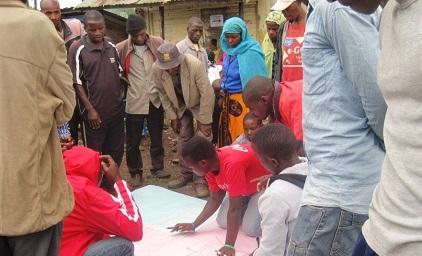
A community in Gombaniro Village, Rusizi District, Rwanda, participates in an exercise to map hazards affecting their village (photo UNISDR/Samuel Okiror)
By Samuel Okiror
KIGALI, 1 May, 2018 - Rwanda has mainstreamed disaster risk reduction (DRR) across all sectors and put in place strong regulations and contingency plans to address all natural and man-made hazards affecting the country.
The country was among the first countries in the world to start using the Sendai Framework Monitor when it was launched in March. This was made possible due to its development of a national disaster loss database, supported by UNISDR under the European Union funded “Building Disaster Resilience to Natural Hazards in Sub-Saharan African Regions, Countries and Communities Programme.” The data will help inform and report on its DRR progress.
The online Sendai Framework Monitor tracks global progress on reducing disaster losses as agreed by UN Member States when they adopted the global plan, the Sendai Framework for Disaster Risk Reduction 2015-203O.
“Disaster risk reduction has been integrated within key development sectors such as infrastructure, agriculture, environment, education, urbanization, information, communications, technology and youth. We are also promoting coherence and synergy with our national and local frameworks,” said Mr. Alphonse Hishamunda, Director DRR and Preparedness Unit, Ministry of Disaster Management and Refugee Affairs (MIDIMAR).
Rwanda has incorporated disaster risk reduction into local development plans in 24 out of 30 districts aimed at preventing the creation of new risk, reducing existing risk and strengthening economic, social, health and environmental resilience.
The country has experienced a growing number of disasters in recent decades. Lightning strikes, floods and landslides triggered by heavy rains and storms are the most frequently occurring disasters.
In 2016 at least 100 people were killed by landslides, particularly in the northern hilly and mountainous area, according to MIDIMAR’s statistics.